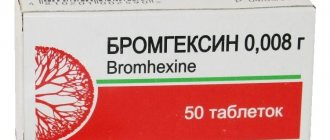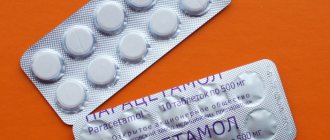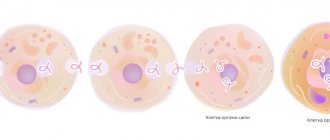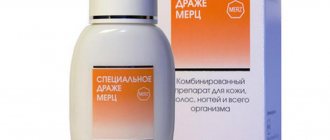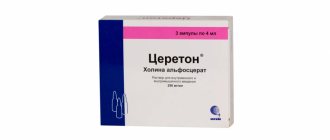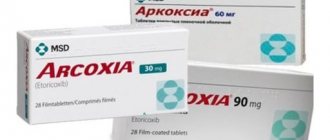Ambrobene is a modern drug from the group of mucolytics and expectorants. It has several mechanisms of action: it reduces the viscosity of sputum, accelerates its transport and excretion, increases the concentration of antibiotics in bronchial secretions, enhances the formation of endogenous surfactant, and has an antioxidant effect.
Ambrobene syrup
Compound
One Ambrobene tablet contains 30 mg of ambroxol , lactose in the form of monohydrate (Lactose monohydrate), corn starch (Maidis amylum), magnesium stearate (Magnesium stearate), anhydrous colloidal silicon dioxide (Silicium dioxide).
One sustained-release capsule contains 75 mg ambroxol , microcrystalline cellulose (Cellulose microcrystalline), Avicel PH 102 and PC 581, triethyl citrate, methacrylic acid ethyl acrylate copolymer msds, hypromellose (Pharmacoat 603; Hypromellose), anhydrous colloidal silicon dioxide. The composition of the shell covering the capsule includes: gelatin, titanium dioxide, dyes (iron oxide red, yellow and black).
100 ml of syrup contains 0.3 grams of ambroxol, sorbitol (Sorbitol) liquid 70%, propylene glycol (Propylene glycol), saccharin (Saccharin), water, raspberry flavoring.
100 ml of solution for oral administration and inhalation includes 0.75 grams of ambroxol , potassium sorbate (Potassium sorbate); hydrochloric acid (Acidum hydrochloricum), water.
2 ml of solution for intravenous administration contains 15 mg of ambroxol , citric acid monohydrate (Acid citric monohydrate), sodium chloride (Sodium chloride), sodium hydrophosphate heptahydrate (Sodium hydrophosphate heptahydrate), water.
Release form
Ambrobene has 5 release forms:
- pills;
- injection solution for intravenous administration;
- retard capsules;
- syrup;
- solution for inhalation and p/os administration.
The tablets are biconvex, round in shape. Their color is white, there is a mark on one side. One package of the drug can contain 2 or 5 blisters of 10 Ambrobene tablets.
The body of retard gelatin capsules is colorless, transparent, the cap is brown, the contents are white or slightly yellowish granules. One package of the drug contains 1 or 2 blisters of 10 capsules.
Syrup is a colorless (or slightly yellowish) transparent liquid with a raspberry odor. In pharmacies it is sold in 100 ml glass bottles. Each bottle is sealed with a jet cap and closed with a plastic screw cap. Each pack comes with a measuring cup.
The solution for inhalation and oral administration is a clear, odorless liquid that can be either colorless or light yellow with a slightly brownish tint. The solution is sold in glass bottles of 40 or 100 ml. Each bottle is sealed with a dropper stopper and closed with a plastic screw cap. Each pack contains a measuring cup.
The solution for injection into a vein is a clear, colorless or slightly yellowish liquid. It is produced in 2 ml ampoules of dark glass (first type), 5 ampoules in a plastic tray, 1 tray per package.
Pharmacodynamics and pharmacokinetics
Ambroxol is a substance that is a metabolite of Bromhexine . Its action is aimed at stimulating prenatal (intrauterine) lung development: the use of the drug increases the synthesis and secretion of pulmonary surfactant , and also blocks its breakdown.
Ambrobene has secretomotor , expectorant and secretolytic effects , activates the function of serous gland cells , which are localized in the bronchial mucosa , increases the amount of mucous secretion and stimulates the release of surfactant in the alveoli and bronchi , helps restore the disturbed balance of the mucous and serous components of sputum.
Ambroxol increases the activity of hydrolyzing enzymes , stimulates the release of lysosomes Clara cells located in and the function of the cilia of the ciliated epithelium , due to which sputum is liquefied and the mucociliary transport of pathological secretions is improved.
In preclinical studies, it was found that ambroxol has an antioxidant effect . When used simultaneously with antibiotics Doxycycline , Amoxicillin , Erythromycin and Cefuroxime , it increases the concentration of the latter in bronchial secretions and sputum.
The effect after using the drug develops approximately half an hour after taking p/os (orally) and approximately 10 minutes to half an hour after rectal administration. The duration of the therapeutic effect is dose-dependent and varies from 6 to 12 hours.
When taken p/os, ambroxol is almost completely absorbed from the digestive tract . Cmax is reached after 1-3 hours. Due to first-pass metabolism, the absolute bioavailability of ambroxol after taking p/os is reduced by about a third.
The resulting metabolites ( glucuronides and dibromoanthranilic acid ) are excreted by the kidneys .
The substance binds approximately 80-90% to blood plasma proteins
Ambroxol penetrates the placental barrier and into the cerebral spinal fluid , and is also excreted in the milk of a nursing woman.
The half-life from plasma is 7-12 hours. The total half-life of the substance and its metabolites is about 22 hours. The drug is mainly excreted by the kidneys in the form of metabolic products of ambroxol (about 90%), and only less than 10% of the substance is excreted in its pure form.
Taking multiple drugs at the same time
Antibacterial therapy, supplemented with Ambrobene, increases the concentration of antibacterial substances in secreted sputum.
The simultaneous use of Ambrobene with antitussives is strictly contraindicated. The liquid sputum produced should immediately leave the lungs and bronchi, thanks to the cough reflex. By suppressing a cough with means such as Sinekod, the patient dooms himself to the development of pneumonia associated with stagnation of mucus from the lungs, where a favorable environment is formed for the proliferation of pathogenic bacteria.
Contraindications
The use of Ambrobene is contraindicated in case of hypersensitivity to the components of the drug, as well as in the first trimester of pregnancy.
Additional contraindications for tablets:
- hypolactasia;
- lactase deficiency;
- glucose-galactose malabsorption;
- age up to 6 years.
Retard capsules are prohibited for children under 12 years of age.
Ambrobene syrup is not prescribed for:
- sucrose-isomaltose malabsorption;
- glucose-galactose malabsorption;
- fructose intolerance.
The medicine is prescribed with caution:
- with the syndrome of immotile cilia ( primary ciliary dyskinesia ) - a genetically determined hereditary abnormality in the development of the structure and function of the ciliated epithelium of the respiratory tract ;
- during pregnancy (in the 2nd and 3rd trimesters);
- during breastfeeding;
- during periods of exacerbation of stomach ulcers or duodenal ulcers (for dosage forms intended for oral administration).
renal function or have been diagnosed with serious liver . In this case, the dose of medication for them should be smaller, and the intervals between doses should be longer.
Side effects
Side effects associated with taking tablets, syrup and extended-release capsules:
- allergic reactions (including skin rashes, itching, shortness of breath, urticaria , angioedema of the face);
- headache;
- increased weakness;
- fever;
- anaphylactic reactions (in extremely rare cases);
- stomach ache;
- nausea;
- constipation/diarrhea;
- vomit;
- increased dryness of the mucous membranes of the respiratory tract and oral cavity;
- rhinorrhea;
- exanthema;
- dysuria.
When using Ambrobene solution for inhalation and oral administration, the following may develop:
- hypersensitivity reactions;
- anaphylactic reactions;
- disorders of taste perception;
- stomach ache;
- increased dryness of the mucous membranes of the throat and mouth;
- dyspepsia;
- vomit;
- diarrhea.
Ambrobene solution for injection into a vein can provoke:
- allergic and anaphylactic reactions;
- fever;
- high intensity headaches;
- feeling very tired;
- stomach ache;
- venous edema;
- weakness;
- nausea and vomiting.
Instructions for use of Ambrobene
The duration of therapy in any dosage form is determined individually and depends on the characteristics of the disease. The maximum duration of treatment with Ambrobene without a doctor's prescription is five days.
The mucolytic effect of the drug occurs provided that the patient consumes large amounts of fluid. Therefore, during treatment with the drug, the patient should drink as much as possible.
All dosage forms intended for p/os should be taken after meals, with the drops pre-mixed with water, tea or fruit juice. It is recommended to take tablets and capsules with plenty of water; the instructions prohibit chewing them.
Ambrobene tablets: instructions for use
The optimal dose for children 6-12 years old is half a tablet 2 or 3 times a day.
Patients over 12 years of age should take the drug 1 tablet three times a day in the first 2-3 days. If the expected effect is not observed, adult patients are allowed to increase the single dose to 2 tablets, the frequency of use of the drug is 2 times a day.
From the 3rd or 4th day of treatment, it is advisable to take 1 tablet of 30 mg twice a day.
Ambrobene capsules: instructions for use
The daily dose of the drug in this dosage form is 1 capsule (75 mg).
Ambrobene syrup: instructions for use
For children, syrup is dosed depending on age. Thus, at the age of up to 24 months, it is recommended to drink 2.5 ml (0.5 measuring cup) twice a day; at the age of 24 months to 6 years - 2.5 ml three times a day; at the age of 6-12 years - 5 ml two or three times a day (according to indications).
Patients over 12 years of age should take cough syrup 10 ml three times a day for the first 2-3 days. If necessary, adult patients are allowed to increase the dose to 20 ml twice a day.
Starting from 3-4 days, treatment is continued by taking 20 ml of syrup per day, the dose is divided into 2 doses.
Instructions for use of Ambrobene for inhalation and orally
The dose of the solution for taking p/os is calculated as follows:
- 2 ml/day. in 2 doses - for children up to 24 months;
- 3 ml/day. in 3 doses - for children from 24 months to 6 years;
- 4-6 ml/day. in 2 or 3 doses (2 ml per dose) - for children 6-12 years old;
- 12 ml/day. in 3 doses - for patients over 12 years of age in the first 2-3 days of treatment (if therapy is ineffective, the dose is increased to 16 ml/day with a frequency of applications 2 times a day);
- 8 ml/day. in 2 doses - for patients over 12 years of age, from 3-4 days of treatment.
When using Ambrobene for inhalation, the use of any modern equipment is allowed, with the exception of steam inhalers.
Inhalations with saline are carried out, for which, immediately before the procedure, the drug is mixed with an isotonic NaCl solution and heated to body temperature. To achieve optimal air humidification, it is recommended to take solutions in a 1:1 ratio.
It should be remembered that taking a deep breath during inhalation therapy provokes cough points, so inhalations are carried out while trying to breathe as usual. Patients diagnosed with bronchial asthma should undergo the procedure after taking bronchodilators .
How to perform inhalations for patients of different age groups:
- for children under 24 months, one or two procedures per day using 1 ml of inhalation solution are indicated;
- for children from 24 months to 6 years of age, procedures are carried out with the same frequency, but using twice the dose of the drug;
- for all other categories of patients, a single dose of Ambrobene solution for inhalation is 2-3 ml, the frequency of procedures is the same - 1 or 2 times a day.
Ambrobene solution: instructions for use
The solution is injected into the vein slowly (for at least 5 minutes), stream or drip, using as a solvent any basic solution whose pH does not exceed 6.3 (isotonic NaCl solution, Ringer-Locke solution, five percent glucose solution are suitable for this purpose ).
The daily dose depends on the patient’s weight; it is measured at the rate of 30 mg per 1 kg of body weight and evenly distributed over 4 administrations per day.
After the disappearance of acute symptoms, it is considered advisable to switch to taking the drug in other dosage forms.
For oral administration
Dosing is done with a measuring cup, taken after meals, and drinking plenty of fluids is also recommended.
- 1 ml of solution is 7.5 mg of ambroxol;
- children under 2 years of age are given 1 ml of solution 2 times a day (15 mg/day);
- from 2 to 6 years, 1 ml of solution 3 times a day (22.5 mg/day);
- from 6 to 12 years, 2 ml of solution 2-3 times/day (30-45 mg/day);
- adults and adolescents are prescribed 4 ml of solution 3 times a day (90 mg/day) during the first 2-3 days of therapy. Next - 4 ml 2 times/day (60 mg/day).
Overdose
Signs of intoxication with an overdose of ambroxol have not been established. There is evidence that exceeding the recommended dose provokes diarrhea and nervous agitation .
Ambroxol is well tolerated when taken orally at a dose of 25 mg per kilogram of body weight per day.
A severe overdose can cause increased salivation , nausea, vomiting, and decreased blood pressure .
In case of serious overdose, intensive therapy is indicated: stimulation of vomiting and gastric lavage. These activities should be carried out in the first hour or two after taking the drug. Further treatment is symptomatic.
Interaction
The simultaneous use of antitussive drugs and ambroxol suppresses the cough reflex , which in turn can provoke stagnation of secretions.
Ambroxol, when used simultaneously with Erythromycin, Amoxicillin, Doxycycline and Cefuroxime, increases the concentration of these antibacterial drugs in sputum and bronchial secretions.
When administering ambroxol into a vein, solutions should be used as solvents whose pH does not exceed 6.3. For ambroxol, this indicator is 5, so too large a difference in pH values can provoke precipitation of the base of the substance.
Is it possible to mix Berodual with Ambrobene?
Berodual is a drug that primarily affects the bronchi. It is indicated for patients with bronchial asthma and patients suffering from bronchospasm of various etiologies. In combination with Ambrobene, the maximum effect of removing pathogenic sputum can be achieved. However, in each specific case, it is necessary to consult a specialist who, knowing the medical history, will answer whether the patient can combine Berodual with Ambrobene or not. In case of individual intolerance to the components, the opposite effect may develop, which will worsen the patient’s condition. For example, if Berodual relaxes the muscles of the bronchi so that the cough reflex is reduced, taking Ambrobene will be contraindicated.
special instructions
In exceptional cases, when using the drug, severe dermatological reactions may occur, including and Stevens-Johnson syndromes . If changes appear on the skin or mucous membranes, you should urgently consult a doctor and stop treatment with Ambrobene.
The calorie content of the syrup is 2.6 kcal/gram of sorbitol. One 5 ml measuring cup contains 2.1 grams of sorbitol, which is equivalent to 0.18 XE (bread units).
Sorbitol has the ability to have a mild laxative effect.
For what cough is Ambrobene prescribed?
Ambrobene is a mucolytic and, like all drugs with mucolytic action , it is advisable to prescribe it for dry cough , which is caused by diseases of the lower respiratory tract.
The medicine optimizes the functioning of epithelial cells and dilutes the pathological secretion, thereby facilitating its expectoration.
If the patient's cough is wet, profuse and productive, there is no need to prescribe drugs to thin the sputum.
In what cases is it recommended to take
There are a number of diseases and conditions for which the doctor prescribes Ambrobene:
- bronchitis;
- cystic fibrosis;
- pneumonia;
- bronchial asthma;
- inflammatory processes in the respiratory tract;
- acute respiratory infections and acute respiratory viral infections.
Chronic and acute diseases of the respiratory tract, in which the mechanism of clearing the lungs of phlegm is disrupted, are successfully treated with the drug "Ambrobene".
Analogs
Level 4 ATX code matches:
Mukolik
Abrol
Ambrosan
Bronchorus
ACC 100
ACC 200
ACC Long
ACC
Mukolwan
Lazolvan
Bromhexine 8
Bromhexine 8 Berlin-Chemie
Bromhexine
Bronchobos
Carbocisteine
Erdomed
Pulmozyme
Pectolvan C
Halixol
Acetylcysteine
Structural analogues of Ambrobene: Ambroxol , Bronchoxol , Bronchorus , Lazolvan , Lazongin , Medox , Neo-Bronchol , Ambrolor , Suprima-Kof , Halixol .
Analogues by mechanism of action are: Ascoril , Acestin , Acetylcysteine , ACC , Bromhexine , Bronchosan , Bronchobos , Joset , Cashnol , Libexin Muco , N-AC-Ratiopharm , Pulmozim , Sinupret , Solvin , Fluditek , Fluifort , Fluimucil , Erdomed , Cofasma , Bronchostop .
Ambrobene for children
Why are tablets and syrup prescribed to children? The use of the drug is indicated for the treatment of respiratory tract diseases that occur in acute or chronic form.
Tablets can be prescribed to a child only upon reaching the age of six, capsules - no earlier than from 12 years of age. The optimal dosage form for children is Ambrobene syrup. However, it should be remembered that for children under 2 years of age, syrup, solution for intravenous administration and solution for p/os and inhalation are prescribed exclusively according to doctor’s indications.
The most important property of Ambrobene is the ability to stimulate the formation of surfactant - a substance that is necessary to ensure normal lung . And it is this property that makes the drug valuable for babies who have problems with the lungs .
Ambrobene is prescribed to newborns, infants and children up to one year old in order to normalize the production of surfactant and prevent the alveoli of the lungs , as well as to prevent bronchitis , which is often complicated by ARVI , from becoming chronic.
The dosage regimen and optimal duration of treatment are determined by the attending physician, taking into account the nature of the disease and the age of the small patient.
In the video advertising of the Ambrobene brand, the emphasis is placed on the fact that the drug is made in Germany, which in itself is a guarantor of its high quality and effectiveness.
The main message of the advertisement is that the standards according to which Ambrobene is created are in no way inferior to the high quality standards and those user characteristics, thanks to which German cars, toys and household appliances have long and firmly earned the recognition of consumers in different countries of the world.
And the manufacturer’s claims about the effectiveness of its product are confirmed by numerous positive reviews about Ambroben for children: according to most mothers, the product is one of the best today, since it works really well and helps the child cope with a severe cough.
Ambrobene during pregnancy
To date, there is no reliable data on the safety of using Ambrobene during pregnancy (in particular, in the first 28 weeks). Studies conducted on animals did not reveal the teratogenic effect of ambroxol.
The use of the drug in the 2nd and 3rd trimesters is possible only as prescribed by a doctor and only after the potential benefits to the mother and possible risks to the fetus have been assessed.
Studies conducted on animals have established that ambroxol has the ability to pass into breast milk. However, the use of the drug in nursing women has not been studied enough, and therefore Ambrobene can be prescribed only after assessing the benefit/risk ratio for the mother and child.
How it affects the body
This medicine thins mucus in the bronchi and lungs and stimulates its rapid elimination from the body. Under the influence of the drug, sputum does not increase in volume, but loses its viscosity. The bonds between molecules are broken, and sputum is easily coughed up. "Ambrobene" refers to expectorant and mucolytic drugs.
The tablets begin to act half an hour after taking them. Depending on their quantity, the effect lasts 6–12 hours. The antioxidant properties of Ambrobene have been proven.
The active substance is excreted by the kidneys. Ambroxol easily enters the spinal fluid. It is able to penetrate into the fetus through the placenta, as well as into breast milk. It is completely eliminated from the body within 22 hours.
Reviews about Ambroben
Reviews of Ambrobene syrup, as well as reviews of tablets, solution for inhalation or solution for intravenous administration, are mostly positive. They are confirmed by fairly high ratings of the medicine on specialized forums, where people share their experience of using this or that medicine: on a five-point scale, Ambrobene is rated at 4.5-4.8 points.
The main advantages of the drug are:
- efficiency;
- performance;
- ease of use;
- tastes pleasant to the child;
- can be used from the first months of a child’s life;
- a large number of dosage forms (tablets, solution for intravenous administration, retard capsules, solution for inhalation and p/os administration, syrup), which allows you to choose the optimal one for yourself.
However, there are also neutral and negative reviews, which are related to the fact that the use of the drug did not produce as pronounced a result as expected.
Lazolvan or Ambrobene: which is better
Lazolvan is a drug with mucolytic and expectorant action. It is based on the same ambroxol as Ambrobene. Lazolvan is produced in the form of syrup. When choosing a medicine to improve sputum rheology, you can focus on both the price and the preferred form of release. Without the opportunity to use Lazolval for inhalation, you can choose Ambrobene. The drugs are identical and are complete analogues of each other. In pharmacies, the cost of Lazolvan is often almost twice as high as the price of Ambrobene.
Ambrobene price
The price of Ambrobene tablets is 54 UAH/165 rubles, extended-release capsules are 59 UAH/190 rubles. The price of Ambrobene syrup for children is 63 UAH/108 rubles. The price of Ambrobene for inhalation 40 ml is 38 UAH/127 rubles, a solution for inhalation 100 ml can be purchased for 62 UAH or 176 rubles.
- Online pharmacies in RussiaRussia
- Online pharmacies in UkraineUkraine
- Online pharmacies in KazakhstanKazakhstan
ZdravCity
- Ambrobene syrup 15mg/5ml 100ml Merckle GmbH.
123 RUR order - Ambrobene stoptussin cap. for oral administration 10 mlTeva Pharmaceutical
RUB 151 order
- Ambrobene stoptussin drops for oral administration 4 mg + 100 mg/ml fl. with cap. 50mlTeva Pharm. enterprises s.r.o.
RUB 365 order
- Ambrobene solution for inhalation and orally 7.5 mg/ml 40 ml n1Merkle GmbH
120 rub. order
Pharmacy Dialogue
- Ambrobene syrup 15mg/5ml 100mlMerckle GmbH
122 RUR order
- Ambrobene solution 7.5 mg/ml 40 ml Merckle GmbH
111 rub. order
- Ambrobene STOPTUSSIN (tab. 4 mg + 100 mg No. 20) Teva Operations
RUB 262 order
- Ambrobene STOPTUSSIN (bottle 10ml)Teva Czech Industries SRO
147 RUR order
- Ambrobene STOPTUSSIN (drops d.pr. orally 4mg+100mg/ml 50ml) Teva Czech Enterprises s.r.o.
RUB 377 order
show more
Pharmacy24
- Ambrobene 75 mg N10 capsules Merkle GmbH, Nimecchina/Acino Pharma AG, Switzerland/Mefa A.G, Switzerland
113 UAH.order - Ambrobene 30 mg No. 20 tablets Merkle GmbH, Nimechchina
56 UAH order
- Ambrobene 100 ml syrup
65 UAH order
- Ambrobene 7.5 mg/ml 100 ml solution
133 UAH order
- Ambrobene 7.5 mg/ml 40 ml solution
71 UAH order
PaniPharmacy
- Ambrobene liquid Ambrobene solution 40ml Germany, Merckle
71 UAH order
- Ambrobene tablets Ambrobene tablets. 30 mg No. 20 Germany, Merckle
63 UAH order
- Ambrobene caps.prol.action. 75 mg No. 10 Ukraine, Merkle
127 UAH order
- Ambrobene liquid Ambrobene solution 100ml Germany, Merckle
138 UAH order
- Ambrobene capsule Ambrobene retard capsules. 75 mg No. 10 Germany, Merckle
105 UAH order
show more
How many drops of Ambrobene Stoptussin should I take?
The dosage depends on the patient’s weight; the drops are diluted in 100 ml of water and taken after meals:
- up to 7 kg 8 drops 3-4 times/day
- 7-12 kg 9 drops 3-4 times/day,
- 12-20 kg, 14 drops 3 times a day,
- 20-30 kg, 14 drops 3-4 times/day,
- 30-40 kg, 16 drops 3-4 times/day,
- 40-50 kg 25 drops 3 times a day,
- 50-70 kg 30 drops 3 times a day,
- more than 70 kg, 40 drops 3 times a day.
If therapy for 3 days does not help, you should consult a doctor. Without the advice of a doctor, use is allowed for no more than 7 days.
Ambrobene Stoptussin, 4 mg+100 mg/ml, drops for oral administration, 50 ml, 1 pc.
Teva, Czech Republic
Price from 272₽
Ambrobene stoptussin, 4mg+100mg, tablets, 20 pcs.
Teva, Poland
Price from 217₽
Ambrobene Stoptussin, 4 mg+100 mg/ml, drops for oral administration, 25 ml, 1 pc.
Teva, Czech Republic
Price from 169₽
There are contraindications. Specialist consultation is required.
